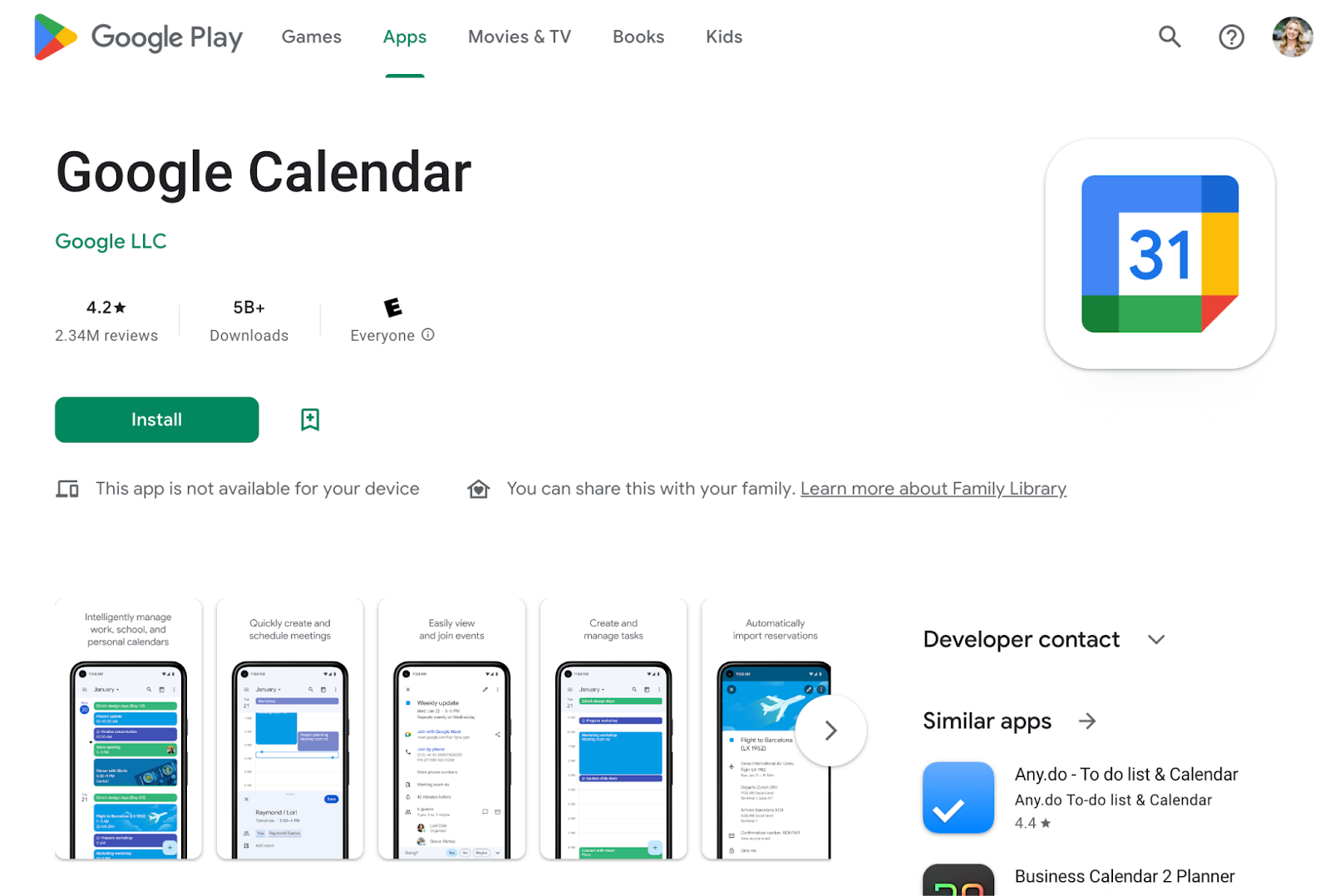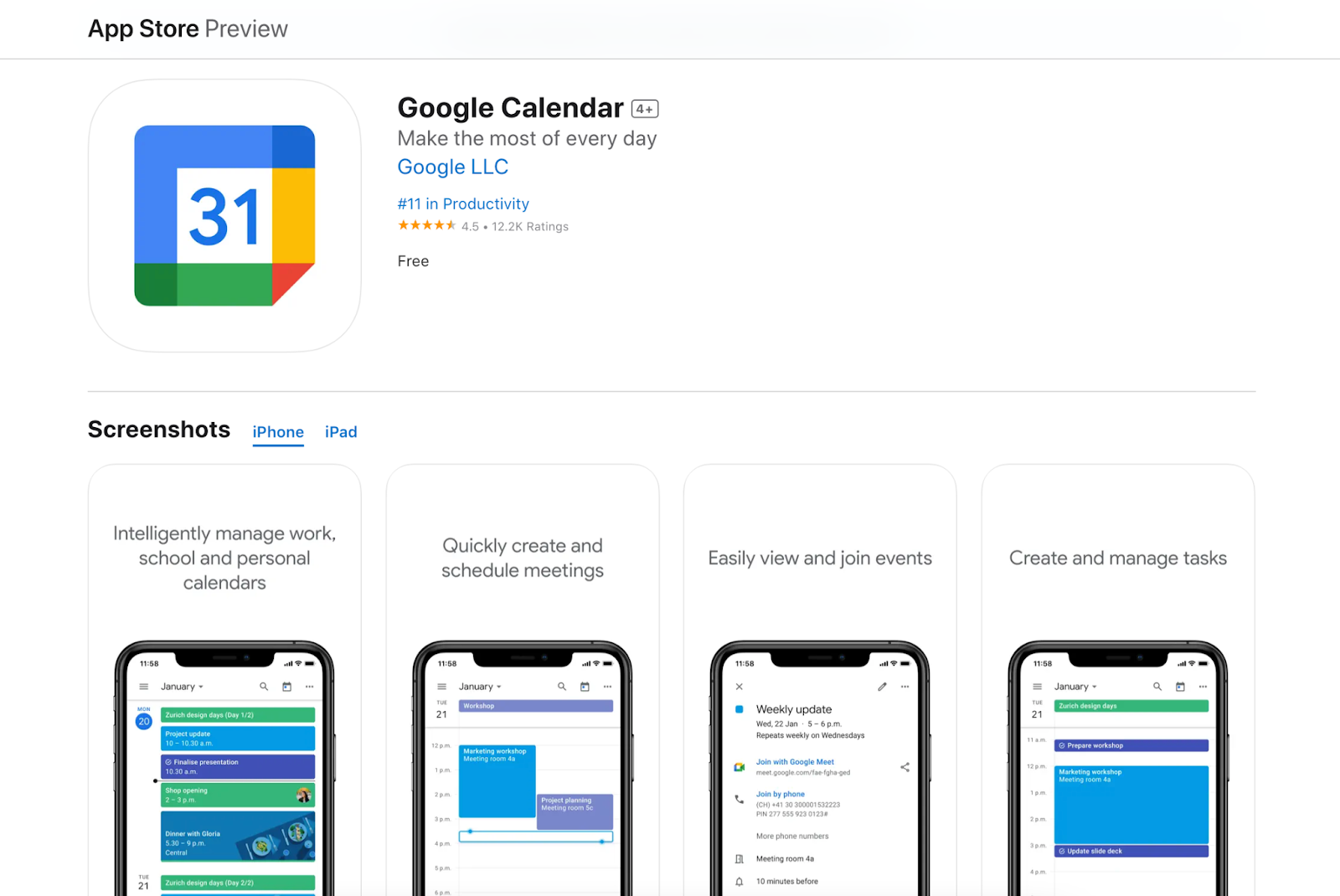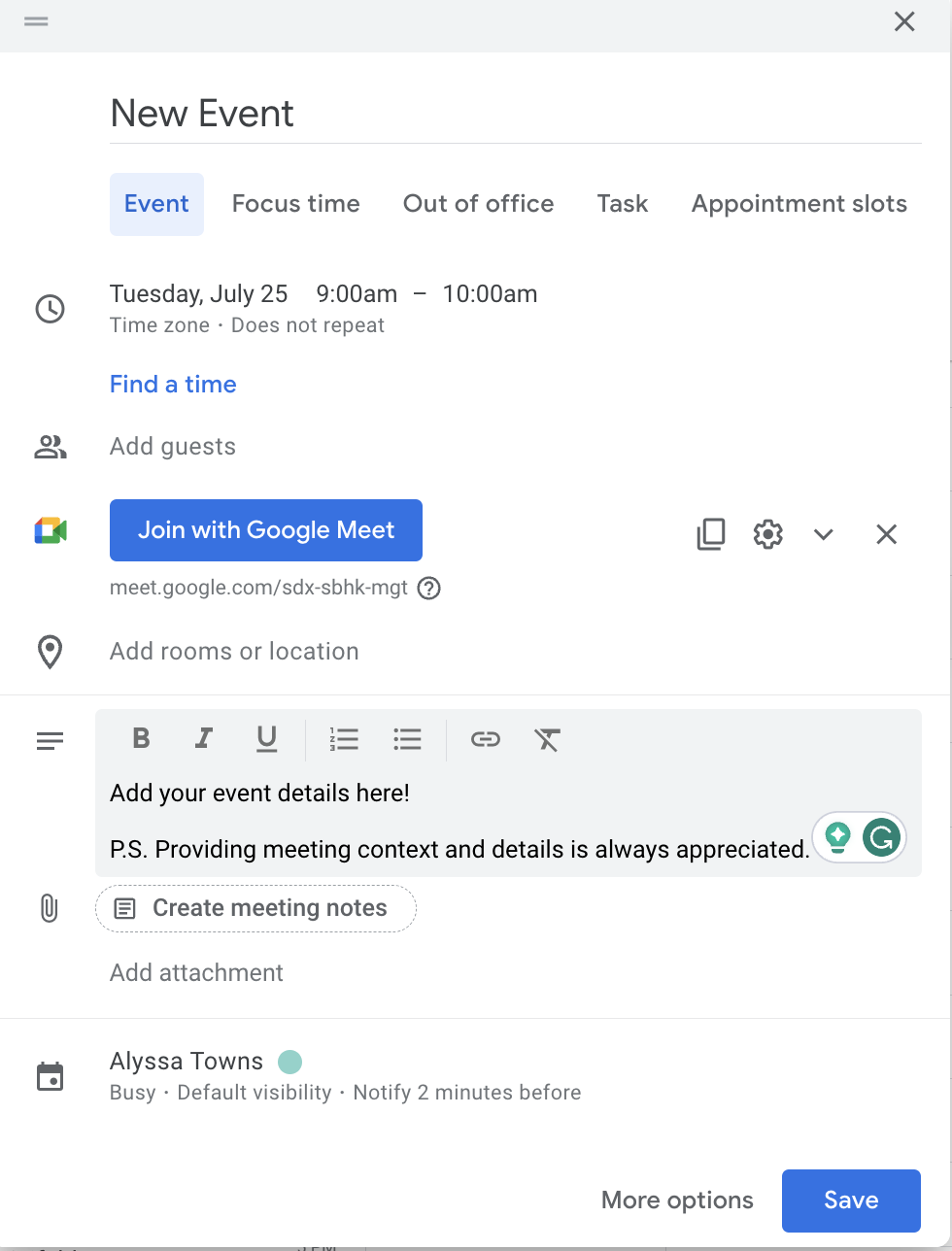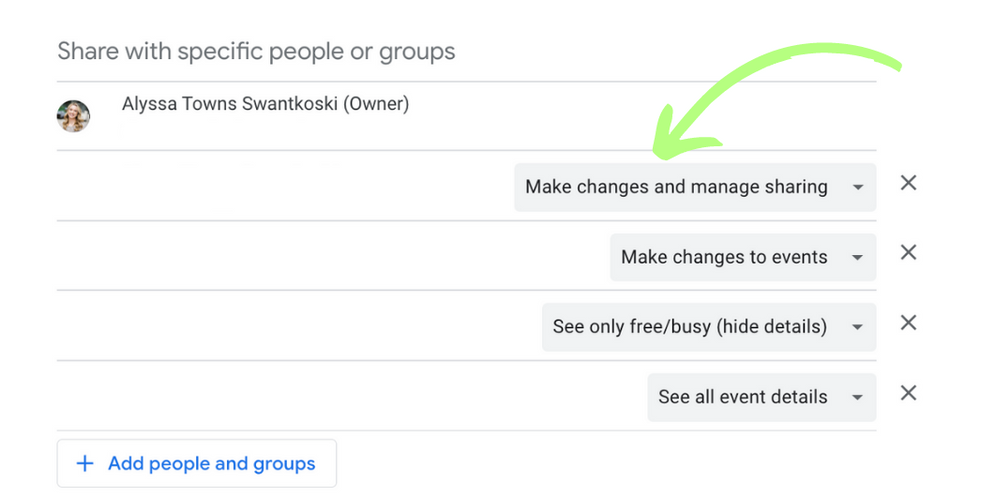Google Calendar isn’t a regular digital calendar. This nifty time management tool is packed with benefits and customizations to help make life easier. Do you know all the best tips and tricks for using Google Calendar? It’s time to find out!
Table of Contents:
- Overview of Google Calendar
- How to create a Google Calendar account
- Downloading and installing the Google Calendar for mobile devices
- Customizing Google Calendar settings
- Creating events
- Sharing your Google Calendar with others
- Syncing Google Calendar with other apps
- Creating multiple calendars
- How to import calendar events
- Creating reminders and notifications
- Setting up daily agenda emails
- Google Calendar for group scheduling
- Keyboard shortcuts
- 4 must-have Google Calendar extensions
1. What is the Google Calendar?
Google released the Google Calendar app, a scheduling and time management calendar tool, in 2009 following its 2006 beta release. It’s available on the web and Android and iOS platforms. Users can create and edit events, manage and schedule tasks, and sync multiple calendars for a centralized view.
Setting up Google Calendar
2. Creating a Google Calendar Account
Setting up a Google Calendar Account is super easy! On your computer, head to Google Calendar and select the “Get started” button to create an account. Follow the steps to create a calendar for personal or business use. You’ll enter your first and last name, desired Gmail address (or use your current email address), and a password. Google will walk you through a series of steps to verify your account before you can get started.
Note: When you create a Google Account to set up a Google Calendar, you can use it to access many Google products in addition to your Google Calendar.
3. Downloading and installing the Google Calendar for mobile devices
Not only can you use Google Calendar on your computer, but you can also download Android or iOS mobile apps.
If you’re an Android user, head to the Google Play store to download and install the Google Calendar app on your Android device(s). Then, open the app and sign in with your Google Account information.

If you’re an iOS device user (iPhone or iPad), navigate to the Google Calendar app page in the App Store on your device. Press the “GET” button to download the app. Open the app and sign in to your Google Account, and you’re all set!

4. Customizing Google Calendar settings
Google Calendar has various options that allow you to customize the calendar to meet your needs. You can customize your event settings, default event duration, notification preferences, views, Gmail event creation, and even the color of your calendar.
To customize your settings on the computer, open your Google Calendar and click the gear icon (Settings menu) in the top right. Scroll through the available options and make your desired changes. Changes get saved automatically, so you're good to go once you finish adjusting your settings to your liking.

You can also customize your settings on the Android and iOS apps. To do this, you’ll need to locate the gear icon to explore the settings menu.
Using the Google Calendar
5. Creating events
There are many ways to create calendar events in Google Calendar. You can select an empty time slot in your calendar, use the “Create” button, create an event from your Gmail inbox, and add events to shared calendars.
Follow these steps for the easiest way to get an event on the calendar:
- Open Google Calendar on your computer
- Navigate to the day, week, or month you want to add an event
- Click the time slot where you want to add an event
- Adjust the time as needed
- Add a title and any event details
- Save your event!

Other nice-to-know tips about creating and managing events:
- You can create all-day and repeating events (which works great for remembering birthdays!)
- It’s easy to add a Google Meet video conferencing link for virtual events (or a Zoom link if you prefer)
- You can add travel time to your Google Calendar for folks who work in office or hybrid environment.
- You can choose a color that your event will show as if you use color-coding
- It takes just a couple of clicks to edit an event after saving (Here’s how: select the event you want to edit and click the pencil icon)
Open the Calendar app on Android and iOS devices and tap the “Create +” button to create an event. Options on mobile are slightly more limited, but you can always customize the events you make on a mobile device on a computer.
Scheduling Meetings
If you are scheduling a meeting, add any attendees you want at the event. You can mark attendees as optional if their attendenace is not mandatory. Be sure to add a video conferencing link to your calendar invite if you are meeting virtually. Be sure to check you're scheduling a time during your co-worker's working hours if you're working with different time zones. Coordinating a time that works with all of your co-workers can be tricky. Clockwise is a free calendar management tool that can automatically schedule the best time to meet for everyone on your team. Consider giving it a try!
6. Sharing your Google Calendar with others
Want to share your calendar with others? No problem! You can share your calendar with specific people or publicize it in the settings menu. Full access allows others to respond to invitations, create and edit events, share your calendar, get notified about changes to your calendar, and delete it. Be mindful of the level of access you give, and always ensure you share your information with people you trust.
Here’s a quick breakdown of the permission settings Google Calendar offers:
- See only free or busy: People can see when you have time blocks on your calendar but won’t be able to see details of your events.
- See all event details: When you share your calendar, the person or people you share with can see details for all events on your calendar unless you mark an event as private.
- Make changes to events: Someone you share with can see all event details (including events you mark as private), and they can add or edit events.
- Make changes and manage sharing: This setting is similar to “Make changes to events” but allows the person you share to delete your Google Calendar permanently.

Sharing permissions may differ on work and school accounts as account admins can limit calendar sharing or turn it off completely.
7. Syncing Google Calendar with other apps
You can sync Google Calendar with some calendar applications like Clockwise! That means you can add and edit events from Google Calendar or your application of choice. Clockwise syncs with your work calendar to help you manage your workday more effectively. And there’s also a Clockwise personal calendar sync that allows you to add events from your personal Google Calendar to your work calendar for a better full-picture view.
You’ll typically find the Google Calendar sync in the settings of whichever calendar applications you use. Follow the appropriate steps to give an app access to your Google Account.
Organizing with Google Calendar
8. Creating multiple calendars
No matter how you prefer to organize and manage your schedule, Google Calendar can support your needs. You can create as many new calendars as you need, and they’ll live under the “My calendars” section in the left-hand panel on the Google Calendar desktop. For example, you could create:
- A meal-planning calendar
- An exercise schedule calendar
- A concert calendar
- A calendar for your side hustle
You can also view multiple calendars by layering them in a single view. This helps identify overlaps and compare event times and schedules.
9. How to import events into Google Calendar
If the fear of losing your current calendar is preventing you from switching to the Google Calendar app, don’t fret. You don’t have to leave behind your old calendar and events if you’re using another tool to help you manage your schedule. Google Calendar makes importing (and exporting) events easy in just a few simple steps.
Follow these steps to get up and running in no time:
1. Export your data from your current calendar. You may need to research how to do this quickly, but most apps make it relatively straightforward. For example, if you use Apple Calendar, open your calendar and select “File” then “Export.”
2. Open your Google Calendar and click the gear icon (Settings menu) in the top right. Select the “Import & export” option.
3. Select your exported data file, and you’re all set!
Note: You can also export your Google Calendar here if you need the source data.

10. Creating reminders and notifications
Sometimes blocking time for an event isn’t enough. Maybe you need reminders to help you track your tasks leading up to a calendar event. Good news—you can use Google Calendar Reminders (soon to be Google Tasks) for private reminders. Reminders repeat until you mark them as done (yes, you can use these like a to-do list!)
For more reminders about upcoming events, you can receive notifications on your phone, computer, or by email. Add or remove notifications based on the specific event type. When you add notifications to an event, you can select how often you want to get alerts in advance.
11. Enabling daily agenda emails
Google Calendar offers a neat and somewhat hidden daily agenda feature, which allows you to request an email of your daily agenda. So if you’re the type of person that hops into your inbox first thing in the morning with a cup of coffee, consider turning this feature on to preview your day as you settle in.
Here’s how to recent daily emails for your calendar:
1. Open your Google Calendar and click the gear icon (Settings menu) in the top right.
2. Locate the “Settings for my calendars” section in the left-hand navigation panel and select which calendars you want to receive a daily agenda for.
3. Scroll down or select “Other notifications” in the left-hand navigation panel.
4. Select “Email” under the “Daily agenda” option in the dropdown menu.

Note: You have to enable this feature per calendar. So, if you want to receive daily emails for your work, personal, and birthday calendars, you’d need to turn this feature on for all three.
12. Using Google Calendar for group scheduling
Scheduling group meetings with Google Calendar saves teams time. Users can layer multiple calendars in a single view to quickly find availability across meeting attendees. Pull up Google Calendar on the computer and use the “Meet with…” box to view multiple calendars simultaneously.
Take group scheduling a step further by downloading Clockwise, which provides smart suggestions for the best times to meet. It considers over ten factors, including time zone, meeting preferences, Focus Time, meeting conflicts, and more!
13. Using Google Calendar keyboard shortcuts
When using Google Calendar on your computer, you can turn on keyboard shortcuts to quickly navigate your calendar. Some shortcuts you can use include refreshing your calendar, jumping to Settings, switching calendar views, and creating new events. Browse the complete list of available shortcuts here in the Google Calendar help center.
Integrating Google Calendar app with other apps
Take advantage of the integrations Google Calendar has to offer! Here’s how Google Calendar integrates with Google Drive and Gmail.
Integrating with Google Drive
You can use Google Drive and Google Calendar together. When creating an event in Google Calendar, select “Add attachment” to include files from Google Drive. No more searching for lost files and wasting time!

Integrating with Gmail
Google Calendar integrates seamlessly with Gmail for an all-in-one user experience. When you open your Gmail inbox, you can access your Google Calendar on the right-side panel. You can even add events to your calendar directly from the Gmail panel instead of opening up a new window or tab for your calendar.
Integrating with Slack
Power users can integrate Google Calendar with Slack to automatically change your Slack status to Out of Office, Lunch, or Focus Time. It will even turn off notification during your Focus Time, so you are not distracted by messages when you are in deep work more.
Integrating with Asana
If your team uses Asana to manage projects, try integrating Google Calendar with Asana to automated time blocking in your Google Calendar, so you never miss a task or project deadline.
Integrating with Zoom
Integrate Google Calendar with Zoom to easily schedule meetings with different teams with a video-conferencing room link in your calendar invites.
14. Four Google Calendar extensions you need
Google Calendar syncs with popular productivity and organization apps. These extensions can make your life even easier and calendaring more effective.
1. Clockwise
Clockwise is an AI-powered productivity tool and scheduling assistant that optimizes individual and team schedules to create more time in the workday for Focus Time and deep work. Clockwise considers users’ preferences and suggests meeting times that work best for all meeting attendees.
You can also:
- Mark meetings as flexible and let Clockwise take care of the rest
- Save Focus Time for your priorities, automatically
- Set up Flexible Holds for tasks and routines that need to happen but can move around
- Share your availability with a scheduling link
2. Event Merge
Event Merge is a Google Chrome extension that visually merges the same event across multiple calendars into one event. Instead of viewing one event multiple times across different
calendars, this extension seamlessly blends the events into one and combines the colors from the calendars so you can quickly distinguish which calendar it came from.
3. Tags for Google Calendar
Tags for Google Calendar allows you to add tags to your event names in Google Calendar. This extension makes it easy to code your events with colors and labels to discern which event is which without creating many calendars.
4. Zoom
Calling all Zoom lovers, this one is for you! Schedule Zoom meetings directly from Google Calendar with this Chrome extension. Not only can you schedule a future meeting, but you can also start instant messaging with the quick click of a button.
Cheers to planning and organizing with Google Calendar
Google Calendar is an all-in-one digital calendar with many great features, including customizable event settings, sharing permissions, reminders, notification settings, and so much more! And Clockwise will elevate your Google Calendar game even further.


.gif)



.png)